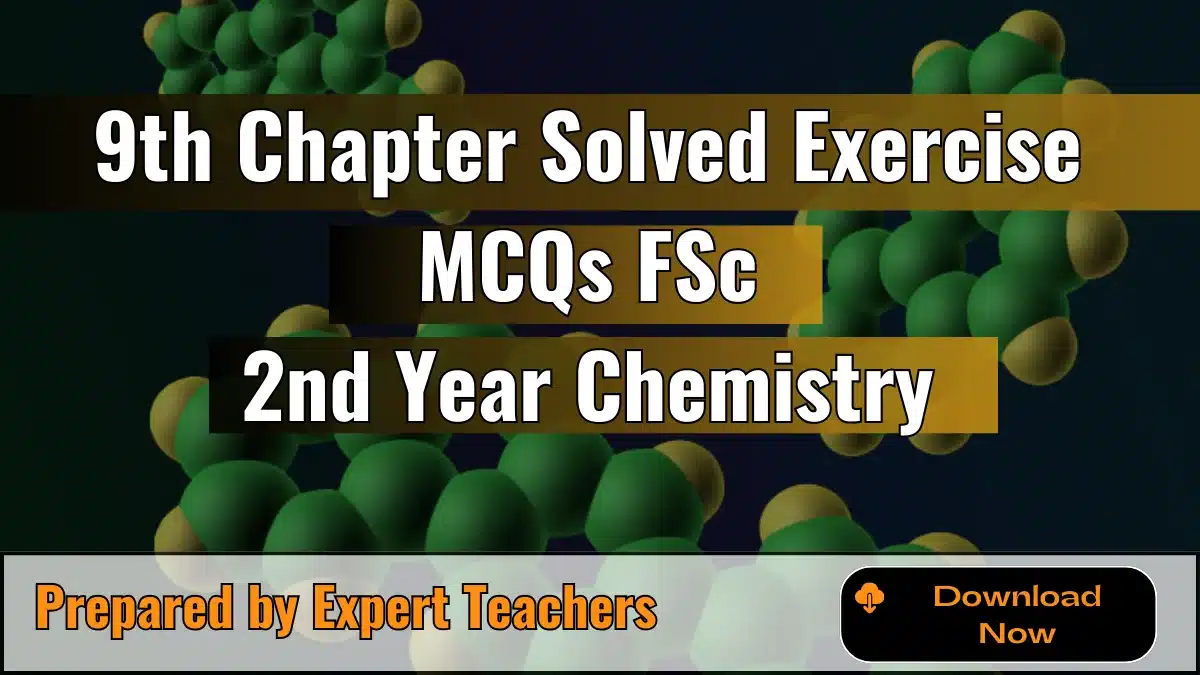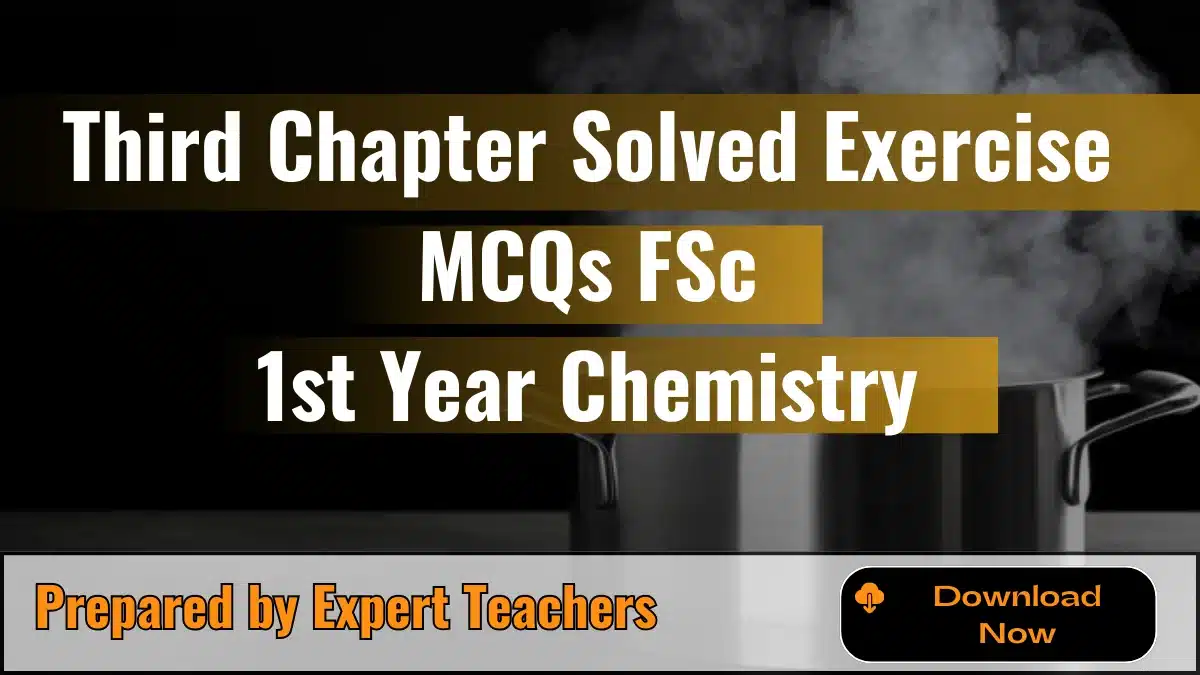8th Chapter Solved Exercise MCQs of FSC Second Year Chemistry
The 8th Chapter Solved Exercise MCQs of FSC 2nd-year Chemistry provides a complete set of solved multiple-choice questions (MCQs). Each MCQ comes with a brief explanation to help you understand the correct answer. These solutions are designed to support students in preparing for their exams, making complex concepts easier to grasp and ensuring a solid foundation for success.
Eight chapter solved MCQs with explanation
1.Preparation of vegetable ghee involves:
(a) Halogenation
(b) Hydrogenation
(c) Hydroxylation
(d) Dehydrogenation
Explanation: Option (b) is correct. Because Vegetable ghee (also known as vanaspati or vegetable oil) is made by hydrogenating vegetable oils. Hydrogenation is a chemical process that adds hydrogen atoms to the unsaturated fatty acids in vegetable oils, converting them into more saturated fats, which solidify at room temperature and give the product a ghee-like consistency.
2. Formula of chloroform is:
(a) CH₃Cl
(b) CCl₄
(c) CH₂Cl₂
(d) CHCl₃
Explanation: Option (d) is correct. Chloroform, also known as tri-chloro methane, has the chemical formula CHCl₃. It is a compound where one hydrogen atom in methane (CH₄) is replaced by three chlorine atoms. The other options listed do not correspond to chloroform:
- CH₃Cl is methyl chloride.
- CCl₄ is carbon tetrachloride.
- CH₂Cl₂ is dichloromethane.
3. The presence of a double bond in a compound is the sign of:
(a) Saturation
(b) Unsaturation
(c) Substitution
(d) None
Explanation: Option (b) is correct. Because A double bond in a compound signifies unsaturation. Unsaturation occurs when a molecule has double or triple bonds, meaning it has fewer hydrogen atoms compared to a saturated compound with only single bonds.
4. Vinyl acetylene combines with HCl to form:
(a) Polyacetylene
(b) Benzene
(c) Chloroprene
(d) Divinyl acetylene
Explanation: Option (c) is correct. Because Vinyl acetylene (HC≡C-CH=CH₂) reacts with hydrochloric acid (HCl). The HCl adds to the molecule, turning it into chloroprene. Chloroprene is a key ingredient in making synthetic rubber like neoprene. The other options are incorrect:
- Polyacetylene is a polymer formed from acetylene, not vinyl acetylene.
- Benzene is an aromatic compound that is not formed from vinyl acetylene.
- Divinyl acetylene is a different compound, and vinyl acetylene does not form it directly with HCl.
5. The addition of unsymmetrical reagent to an unsymmetrical alkene is in accordance with the rule:
(a) Hund’s rule
(b) Markownikov’s rule
(c) Pauli’s Exclusion Principle
(d) Aufbau Principle
Explanation: Option (b) is correct. Because when you add a chemical to an unsymmetrical alkene (an alkene that doesn’t have the same groups on both sides), Markownikov’s rule helps predict where each part of the chemical will go. According to this rule:
- The more stable part of the alkene (the carbon with more hydrogen atoms) will attract the positive part of the new chemical.
- The less stable carbon (with fewer hydrogen atoms) will get the negative part of the new chemical. So, Markownikov’s rule helps us understand how the new chemical will be added to the alkene.
6. Synthetic rubber is made by polymerization of:
(a) Chloroform
(b) Acetylene
(c) Divinylacetylene
(d) Chloroprene
Explanation: Option (d) is correct. Because Synthetic rubber, such as neoprene, is made by polymerizing chloroprene (2-chloro-1, 3-butadiene). Chloroprene polymerization forms neoprene, known for its durability and resistance to various conditions. The other options do not produce synthetic rubber in this manner.
7. β-β’- dichloroethyl sulphide is commonly known as:
(a) Mustard gas
(b) Laughing gas
(c) Phosgene gas
(d) Bio-gas
Explanation: Option (a) is correct. β-β’-dichloroethyl sulphide is commonly known as mustard gas. It is a chemical warfare agent used during World War I and is known for its blistering effects on the skin and mucous membranes. Mustard gas has the chemical formula C₄H₈Cl₂S and is not related to laughing gas, phosgene gas (COCl₂), or bio-gas (which is a mixture of methane and carbon dioxide).
8. When methane reacts with Cl₂ in the presence of diffused sunlight, the products obtained are:
(a) Chloroform only
(b) Carbon tetrachloride only
(c) Chloromethane and dichloromethane
(d) Mixture of a, b, c
Explanation: Option (d) is correct. Because when methane (CH₂) reacts with chlorine (Cl₂) in the presence of diffused sunlight, a substitution reaction occurs where hydrogen atoms in methane are replaced by chlorine atoms. This reaction proceeds through multiple steps, leading to various chlorinated methane products. The reaction can produce:
- Chloromethane (CH₃Cl) – The first chlorination product.
- Dichloromethane (CH₂ Cl₂) – The second chlorination product.
- Chloroform (CHCl₃) – The third chlorination product.
- Carbon tetrachloride (CCl₄) – The fourth chlorination product.
- Because these products are formed sequentially, a mixture of all these products (a, b, c) is obtained in varying proportions, depending on the reaction conditions and duration.
9. Which one of the following gases is used for artificial ripening of fruits?
(a) Ethene
(b) Ethyne
(c) Methane
(d) Propane
Explanation: Option (a) is correct. Because Ethene (also known as ethylene) is a plant hormone that accelerates the ripening process of fruits. It is commonly used in the agricultural industry to induce ripening in fruits such as bananas, tomatoes, and apples. Ethyne (acetylene), methane, and propane are not used for this purpose.







Leave a Reply